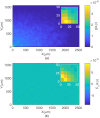Anomalous diffusion and q-Weibull velocity distributions in epithelial cell migration
- PMID: 28700652
- PMCID: PMC5507264
- DOI: 10.1371/journal.pone.0180777
Anomalous diffusion and q-Weibull velocity distributions in epithelial cell migration
Abstract
In multicellular organisms, cell motility is central in all morphogenetic processes, tissue maintenance, wound healing and immune surveillance. Hence, the control of cell motion is a major demand in the creation of artificial tissues and organs. Here, cell migration assays on plastic 2D surfaces involving normal (MDCK) and tumoral (B16F10) epithelial cell lines were performed varying the initial density of plated cells. Through time-lapse microscopy quantities such as speed distributions, velocity autocorrelations and spatial correlations, as well as the scaling of mean-squared displacements were determined. We find that these cells exhibit anomalous diffusion with q-Weibull speed distributions that evolves non-monotonically to a Maxwellian distribution as the initial density of plated cells increases. Although short-ranged spatial velocity correlations mark the formation of small cell clusters, the emergence of collective motion was not observed. Finally, simulational results from a correlated random walk and the Vicsek model of collective dynamics evidence that fluctuations in cell velocity orientations are sufficient to produce q-Weibull speed distributions seen in our migration assays.
Conflict of interest statement
Figures










Similar articles
-
Normal and tumoral melanocytes exhibit q-Gaussian random search patterns.PLoS One. 2014 Sep 9;9(9):e104253. doi: 10.1371/journal.pone.0104253. eCollection 2014. PLoS One. 2014. PMID: 25203532 Free PMC article.
-
Multicellular density fluctuations in epithelial monolayers.Phys Rev E Stat Nonlin Soft Matter Phys. 2015 Sep;92(3):032729. doi: 10.1103/PhysRevE.92.032729. Epub 2015 Sep 30. Phys Rev E Stat Nonlin Soft Matter Phys. 2015. PMID: 26465520
-
Cellular Contraction Can Drive Rapid Epithelial Flows.Biophys J. 2017 Oct 3;113(7):1613-1622. doi: 10.1016/j.bpj.2017.08.004. Biophys J. 2017. PMID: 28978451 Free PMC article.
-
Phenomenological approaches to collective behavior in epithelial cell migration.Biochim Biophys Acta. 2015 Nov;1853(11 Pt B):3143-52. doi: 10.1016/j.bbamcr.2015.05.021. Epub 2015 May 29. Biochim Biophys Acta. 2015. PMID: 26028592 Review.
-
Computational Modeling of Collective Cell Migration: Mechanical and Biochemical Aspects.Adv Exp Med Biol. 2019;1146:1-11. doi: 10.1007/978-3-030-17593-1_1. Adv Exp Med Biol. 2019. PMID: 31612450 Review.
Cited by
-
Swarming Transition in Super-Diffusive Self-Propelled Particles.Entropy (Basel). 2023 May 18;25(5):817. doi: 10.3390/e25050817. Entropy (Basel). 2023. PMID: 37238572 Free PMC article.
-
Interplay Between the Persistent Random Walk and the Contact Inhibition of Locomotion Leads to Collective Cell Behaviors.Bull Math Biol. 2019 Aug;81(8):3301-3321. doi: 10.1007/s11538-019-00585-1. Epub 2019 Feb 20. Bull Math Biol. 2019. PMID: 30788690 Free PMC article.
-
Study of Wound Healing Dynamics by Single Pseudo-Particle Tracking in Phase Contrast Images Acquired in Time-Lapse.Entropy (Basel). 2021 Feb 26;23(3):284. doi: 10.3390/e23030284. Entropy (Basel). 2021. PMID: 33652826 Free PMC article.
References
-
- Bray D (2001) Cell movements: from molecules to motility. New York: Garling Publishing.
-
- Blitterswijk CV et al. eds. (2008) Tissue engineering. London: Academic Press
-
- Marchetti MC, Joanny JF, Ramaswamy S, Liverpool TB, Prost J, Rao M. et al. (2013) Hydrodynamicsof soft active matter. Rev. Mod. Phys. 25: 1143–1189.
MeSH terms
LinkOut - more resources
Full Text Sources
Other Literature Sources

